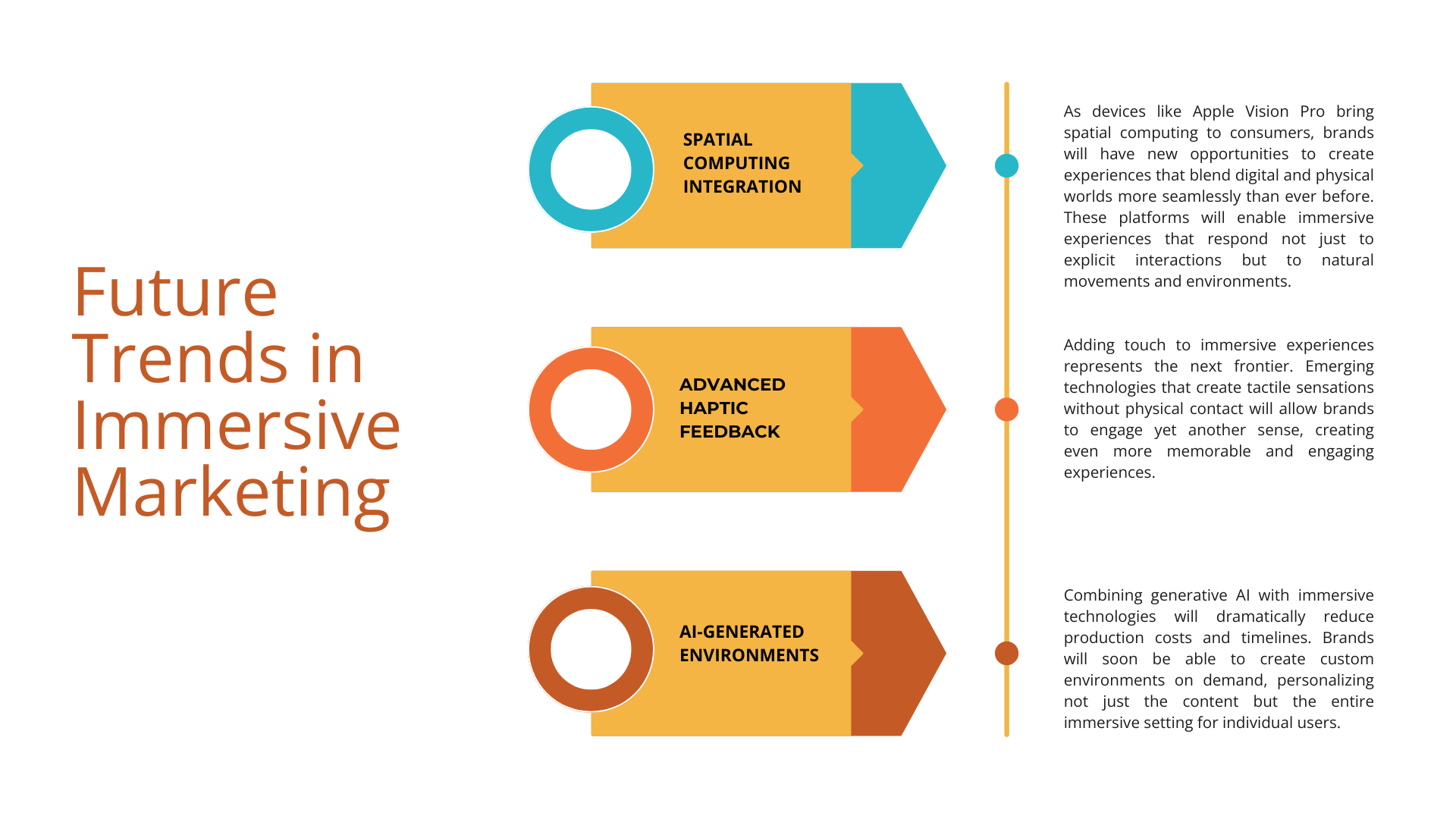How Immersive Experiences Are Revolutionizing Marketing
Traditional forms of advertising are no longer engaging users. Instead, consumers demand interactive experiences. Brands can use immersive marketing to meet this demand.
The global immersive marketing market has reached $6.90 billion in 2024, sending a clear message to marketers everywhere: multisensory, interactive brand experiences aren’t just innovative—they’re essential. This staggering figure represents more than just spending; it reflects a shift in how consumers are interacting with brands.
For marketing professionals, this growth signals opportunity. As traditional advertising continues to lose effectiveness amid growing consumer ad fatigue, immersive marketing experiences are proving to be remarkably resilient against diminishing returns. They’re achieving what conventional campaigns increasingly struggle to deliver: genuine engagement, emotional connection, and measurable business outcomes.
In this article, we’ll explore how leading brands are leveraging augmented reality, virtual reality, and AI to create captivating experiences that not only reach audiences but also envelop them. More importantly, we’ll examine the concrete strategies and technologies that are making these campaigns not just creative showcases, but drivers of tangible business growth.
TABLE OF CONTENTS:
- Key Takeaways
- What Are Immersive Marketing Experiences?
- Why Immersive Marketing Matters Now
- Core Technologies Driving Immersive Experiences
- Best Practices When Using Immersive Experiences
- Successful Immersive Marketing Campaigns: Case Studies
- Measuring Success: Metrics That Matter
- Overcoming Common Challenges
- Future Trends in Immersive Marketing
- Immersive Experiences Are the Future
Key Takeaways
- Immersive marketing experiences deliver a proven ROI, with 71% of brands reporting positive returns and 38% seeing an ROI increase of over 20% compared to traditional campaigns.
- Three core technologies power effective immersive marketing: Augmented Reality (AR) for accessible product visualization, Virtual Reality (VR) for complete environment control, and AI for real-time personalization.
- Successful immersive marketing requires clear business objectives, rather than a technology-first approach, to ensure campaigns align with specific goals, such as brand awareness, education, conversion, or loyalty.
- Measuring immersive marketing success demands new metrics beyond traditional KPIs, including engagement depth, emotional response tracking, and specific business impact measurements.
- Brands using immersive product demonstrations during launches experienced a 22% higher conversion rate, demonstrating the tangible business impact of these interactive experiences.
What Are Immersive Marketing Experiences?
Immersive marketing experiences use multisensory technology to create engaging experiences that boost interactions among audiences. These experiences are lifelike and captivating enough to create deep connections with consumers.
Unlike traditional advertising, immersive marketing invites them to step inside a brand’s world, interact with it, and form memories through direct experience.
These experiences blur the boundaries between the physical and digital worlds, leveraging technologies such as augmented reality (AR), virtual reality (VR), mixed reality (MR), and artificial intelligence (AI) to create environments that respond to user actions in real time. The result is a more profound connection between consumer and brand—one built on interaction rather than interruption.
What makes immersive marketing particularly powerful is its ability to engage multiple senses at the same time. When brands can stimulate sight, sound, touch, and even smell or taste, they create richer memory structures in consumers’ minds. This multidimensional engagement leads to stronger brand recall and emotional resonance than single-channel approaches can achieve.
Why Immersive Marketing Matters Now
Immersive marketing is helping brands break through clutter and create meaningful relationships with their audience. Modern technology breaks down the boundaries of advertising, offering a more compelling way to promote products and services.
According to the Immersive Experience Network, 68% of immersive experience attendees reported a stronger emotional connection to brands—a figure that should make any marketing professional take notice.
Perhaps even more convincing is the financial picture. Research from AnyRoad reveals that 71% of brands that invested in immersive marketing in 2024 reported a positive ROI, with 38% seeing ROI increases over 20% compared to traditional campaigns. This doesn’t just validate immersive marketing as a creative approach—it establishes it as a business-critical strategy with measurable financial benefits.
The generational dimension adds another layer of significance. According to Seeker.io, 72% of Millennials are more inclined to engage with brands offering immersive or experiential marketing campaigns. As these consumers solidify their position as the dominant purchasing power in most markets, their preferences can’t be ignored.
Perhaps most compelling for product-focused marketers is the conversion impact: brands leveraging immersive product demonstrations during launches saw a 22% higher conversion rate among engaged consumers. In an era where conversion optimization often focuses on incremental gains, a double-digit lift is remarkable.
Core Technologies Driving Immersive Experiences
The rise of immersive marketing experiences is linked to several key technologies. Understanding these tools is essential for marketers looking to make virtual experiences more interactive.
Augmented Reality (AR)
AR overlays 3D-generated content onto the real world, typically through smartphone cameras or specialized glasses. What makes AR particularly valuable for marketers is its accessibility—consumers can engage with AR experiences using devices they already own.
Retail brands have been especially successful with AR implementation. IKEA’s AR app allows customers to visualize furniture in their homes before making a purchase, enhancing shopping confidence and reducing returns. Similarly, beauty brands like Beetles Gel Polish have implemented virtual try-on experiences, allowing customers to see how different shades look on their actual nails before making a purchase.
The technology is particularly effective for product visualization, wayfinding (in-store navigation), packaging enhancement, and educational content that requires contextual overlays.
Virtual Reality (VR)
While AR enhances reality, VR creates entirely new environments. Through headsets that fully immerse users in digital worlds, VR offers unparalleled potential for storytelling and experience creation.
Automotive companies have been early adopters, creating virtual test drives that let consumers experience vehicles without visiting dealerships. Škoda and Ford collaborated with ServReality to develop virtual reality (VR) vehicle simulators, allowing customers to explore new models online. This resulted in a 30% increase in customer engagement and a 20% reduction in sales cycle time.
VR excels at creating memorable branded environments, delivering product demonstrations that would be impossible or impractical in the real world, and generating robust emotional responses through immersive storytelling.
AI-Powered Personalization
Artificial intelligence serves as the invisible backbone of many immersive experiences, allowing them to adapt in real-time to individual user behaviors and preferences. AI algorithms analyze user interactions to personalize immersive experiences in real-time, creating uniquely relevant journeys for each participant. This technology enables experiences to evolve based on demonstrated interests, creating a more engaging and personally relevant interaction. The combination of AI with AR or VR is potent, as it enables experiences that not only immerse consumers but also understand and respond to their individual preferences and behaviors.
Best Practices When Using Immersive Experiences
Creating successful immersive marketing experiences requires more than just implementing new technologies. Here are key strategies when leveraging this technology.
Align With Clear Objectives
Every immersive experience should start with specific business goals. Understanding what you want to achieve with immersive experiences will ensure you get the outcomes that you desire. Here are some common goals that marketers establish with immersive experiences:
- Brand awareness: Create memorable, shareable experiences that extend reach.
- Education: Use immersion to simplify complex product features or benefits.
- Conversion: Implement virtual try-ons or demonstrations that reduce purchase hesitation.
- Loyalty: Develop exclusive immersive content for existing customers.
The technology should follow the strategy, not determine it. Successful brands start with the desired customer outcome and select technologies that best deliver that result.
Design for Accessibility
While cutting-edge technology offers exciting possibilities, the most successful immersive campaigns prioritize accessibility. Consider:
- Using web-based AR that doesn’t require app downloads.
- Offering both high-end and simplified versions of experiences.
- Ensuring experiences work across multiple device types.
- Providing alternative engagement paths for users without access to specific technologies.
The most effective immersive campaigns strike a balance between technological innovation and practical reach, ensuring the experience is available to the broadest possible segment of the target audience.
Integrate Across Channels
Immersive experiences deliver maximum impact when integrated into broader marketing platforms. Consider adding immersive technology to these channels:
- Using social media to amplify and extend immersive moments
- Connecting physical retail with digital immersive elements
- Incorporating immersive touchpoints throughout the customer journey
- Capturing data from immersive interactions to inform other marketing initiatives
The most successful brands view immersive marketing as an enhancement to their overall marketing storytelling. Use different channels to capture your audience where they are and use consistent brand messaging to establish a connection.
Successful Immersive Marketing Campaigns: Case Studies
Case Study: Gucci Garden on Roblox
- Challenge: Engage younger, digitally native audiences and reinforce brand relevance beyond traditional marketing channels.
- Solution: Launched “Gucci Garden” on Roblox—a virtual recreation of their Florence garden featuring interactive art installations, virtual fashion shows, and limited-edition digital wearables.
- Results: Within the first week, over 4.5 million Roblox users engaged, with total visits exceeding 20 million in the first month and over $1.2 million in virtual item sales.
- Key Takeaway: Integrating brand experiences into metaverse platforms can drive both deep engagement and tangible sales.
The Gucci case demonstrates how luxury brands can leverage immersive platforms to create experiences that would be impossible in the physical world alone. They targeted their audience in digital spaces where they already inhabit, achieving not just brand awareness but a new revenue stream through digital products.
Case Study: IKEA Place AR App
- Challenge: Enhance the customer shopping experience and increase confidence in purchase decisions.
- Solution: Implemented AR technology to allow customers to visualize furniture in their homes before purchasing.
- Results: Significantly enhanced shopping experience, increased customer confidence, and reduced return rates.
- Key Takeaway: Using AR to simulate real-life environments can significantly boost customer trust and purchase confidence.
IKEA’s approach demonstrates how immersive technology can solve a specific customer pain point—uncertainty about how products will look in their space. After addressing this friction point directly, IKEA created an experience that was not just engaging but genuinely useful, driving both immediate sales and long-term loyalty.
Measuring Success: Metrics That Matter
Measuring the impact of immersive marketing requires looking beyond traditional marketing metrics. The most effective tactics combine standard KPIs with these specific examples:
| Metric Category | Specific Measurements | Why It Matters |
|---|---|---|
| Engagement Depth | Time spent, interaction rate, completion rate | Measures how thoroughly users explore the experience |
| Emotional Response | Sentiment analysis, emotional tracking | Captures the emotional impact often missing from traditional metrics |
| Business Impact | Conversion lift, purchase intent change, brand recall | Connects immersive experiences to tangible business outcomes |
| Sharing & Amplification | Social shares, user-generated content, earned media | Tracks how experiences extend beyond initial participants |
The most sophisticated brands are implementing pre- and post-experience surveys to measure shifts in perception and intent. This will help marketers track the KPIs that matter so their strategies evolve.
Overcoming Common Challenges
While immersive marketing offers tremendous potential, it often faces these specific challenges.
Technical Barriers
Many brands struggle with the technical complexity of immersive experiences. Successful organizations typically address this through:
- Partnering with specialized agencies for initial implementations
- Using no-code or low-code platforms that simplify creation
- Starting with simpler implementations before advancing to more complex experiences
- Creating reusable technical frameworks that can support multiple campaigns
User Hurdles
Even the best immersive experiences fail if the target audience doesn’t engage. Effective approaches include:
- Providing clear, simple onboarding instructions.
- Offering immediate value early in the experience.
- Using familiar interaction patterns where possible.
- Creating sufficient motivation through rewards or unique content.
Not Measuring the Right Metrics
While marketers must measure metrics to ensure their immersive experiences have the maximum impact, traditional analytics often fall short for these types of experiences. Leading brands are:
- Implementing specialized analytics platforms designed for spatial experiences
- Combining quantitative metrics with qualitative feedback
- Developing custom attribution models for each touchpoint
- Testing in increments to test the impact of each immersive element
Future Trends in Immersive Marketing

The immersive marketing landscape continues to evolve rapidly. Forward-thinking marketers should keep an eye on these emerging trends.
- Spatial computing integration: As devices like Apple Vision Pro bring spatial computing to consumers, brands will have new opportunities to create experiences that blend digital and physical worlds more seamlessly than ever before. These platforms will enable immersive experiences that respond not just to explicit interactions but to natural movements and environments.
- Advanced haptic feedback: Adding touch to immersive experiences represents the next frontier. Emerging technologies that create tactile sensations without physical contact will allow brands to engage yet another sense, creating even more memorable and engaging experiences.
- AI-generated environments: Combining generative AI with immersive technologies will dramatically reduce production costs and timelines. Brands will soon be able to create custom environments on demand, personalizing not just the content but the entire immersive setting for individual users.
As these technologies mature, the line between physical and digital marketing will continue to blur, creating opportunities for brands that can effectively operate across this continuum.
Immersive Experiences Are the Future
Traditional advertising doesn’t drive results like it used to. That’s why immersive experiences are becoming essential to promoting your brand and products. The question is how to incorporate multisensory technology and do so most effectively. Successful brands will be those that use technological innovation to create meaningful relationships with their audience.
Immersive marketing is already underway. Is your brand prepared for this innovation? If you’re ready to explore immersive marketing experiences, work with the leading digital marketing agency that specializes in creating data-driven campaigns that deliver measurable results.




